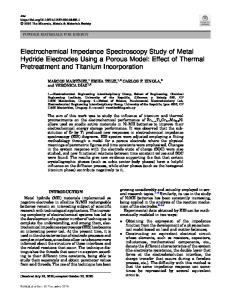Study of polymer-electrode interfaces in polymer light-emitting diodes using electrical impedance spectroscopy
- PDF / 123,148 Bytes
- 6 Pages / 612 x 792 pts (letter) Page_size
- 99 Downloads / 308 Views
B6.2.1
Study of polymer-electrode interfaces in polymer light-emitting diodes using electrical impedance spectroscopy A. van Dijken1, I.N. Hulea2, H.B. Brom2, K. Brunner1 1 2
Philips Research Laboratories, Eindhoven, The Netherlands Kamerlingh Onnes Laboratory, Leiden University, Leiden, The Netherlands
ABSTRACT Electrical impedance spectroscopy is used to show that time-dependent charge trapping processes occur in double-layer polymer light-emitting diodes based on poly(ethylenedioxythiophene):poly(styrene sulfonic acid) (PEDOT:PSS) and poly(p-phenylene vinylene) (PPV). No time-dependent charge trapping processes are observed in single-layer devices based on PPV only. Furthermore, in double-layer devices based on poly(2,7-spirofluorene) (PSF) instead of PPV, such processes are also absent. Traps are probably created in the PPV layer close to the PEDOT:PSS interface due to chemical reactions that occur specifically between PEDOT:PSS and PPV.
INTRODUCTION Polymer light-emitting diodes are very interesting for display applications and have received considerable attention the last couple of years. A clear understanding of the various physical phenomena governing the behavior of these devices is very important. In this paper, electrical impedance spectroscopy is used to study polymer light-emitting diodes. This is a powerful method to characterize the electrical behavior of a system and to study physical processes occuring at interfaces [1]. Electrical impedance spectroscopy has been used before to study the properties of polymer light-emitting diodes, such as charge trapping [2,3], and Schottky behavior at the polymer-cathode interface [4].
EXPERIMENTAL DETAILS Polymer light-emitting diodes were fabricated by spin coating organic layers on pre-cleaned indium-tin oxide coated glass substrates. Two types of devices were fabricated : (a) single-layer devices, and (b) double-layer devices. Single-layer devices employ only a light-emitting polymer (LEP) layer sandwiched between two electrodes. In double-layer devices a layer of poly(3,4ethylenedioxythiophene):poly(styrene sulfonic acid) (PEDOT:PSS, 1:6 dispersion, HC Starck [5]) is used. PEDOT:PSS layers were annealed at 180 °C for 2 minutes. LEPs based on poly(pphenylenevinylene) (PPV) [6,7] and poly(2,7-spirofluorene) (PSF) [8] were used. Metal cathodes were applied by vacuum evaporation through a mask and consisted of either Au or Ba/Al (5 nm Ba capped with 100 nm Al). With a Au cathode, a unipolar device is obtained in which the current is being carried by holes only. A bipolar device is obtained with Ba/Al as cathode. The
B6.2.2
devices were fabricated in a nitrogen atmosphere inside a glove box. Before the devices leave the glove box, they are encapsulated with a metal lid to prevent oxygen and water from damaging the device performance. Electrical impedance measurements were performed using a Schlumberger SI 1260 impedance/gain-phase analyzer. The impedance is measured by applying a sinusoidally-varying voltage modulation (rms amplitude 30 mV), superimposed o
Data Loading...











